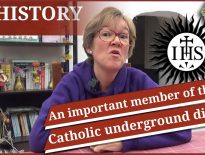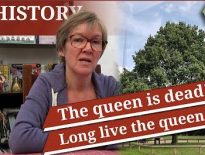On this day in Tudor history, 18th November 1559, eighty-five-year-old Cuthbert Tunstall, Bishop of Durham, died while in the custody of Matthew Parker, Archbishop of Canterbury, at Lambeth Palace.
Cuthbert Tunstall had an amazing career which spanned the reigns of Henry VIII, Edward VI and Mary I, and he was imprisoned in two of those monarchs' reigns. In today's talk, I give an overview of this bishop's interesting life and career.
Also on this day in Tudor history:
- 1531 – Birth of Roberto di Ridolfi, merchant, banker and conspirator, in Florence, Italy. In the 1570s, Ridolfi, who was a papal agent, acted as a go-between for the Spanish and the Duke of Norfolk, and was the man responsible for funding the rebellion which aimed to have a Northern Catholic rebellion and an invasion by Spanish forces under Philip of Spain. The plot became known as the Ridolfi Plot, and was uncovered before it was put into action.
- 1559 – Death of Ralph Baynes, Bishop of Coventry and Lichfield, during his imprisonment at the London home of Edmund Grindal, Bishop of London. He was buried in the church of St Dunstan-in-the-West, London. Baynes had been deprived of his bishopric and put into the care of Grindal in June 1559, due to his opposition to Elizabeth I's religious legislation.
- 1600 – Death of William Hughes, Bishop of St Asaph and former chaplain to Thomas Howard, 4th Duke of Norfolk, at Diserth. He was buried in the cathedral choir. Hughes acted as patron to the Welsh poets William Cynwal, William Llŷn, and Siôn Tudur.
Transcript:
On this day in Tudor history, 18th November 1559, eighty-five-year-old Cuthbert Tunstall, Bishop of Durham, died while in the custody of Matthew Parker, Archbishop of Canterbury, at Lambeth Palace.
Tunstall had had an amazing career, which spanned the reigns of Henry VIII, Edward VI and Mary I. However, he fell from grace in Queen Elizabeth I’s reign after he refused to take the Oath of Supremacy and refused to participate in the consecration of Matthew Parker as Archbishop of Canterbury.
Let me tell you a bit about this man...
Cuthbert Tunstall was born in 1474 in Hackforth, Yorkshire. He started out as the illegitimate son of Thomas Tunstall of Thurland Castle, Lancashire, but Cuthbert’s mother did marry Thomas so Cuthbert became legitimate. He was educated at Balliol College, Oxford, and King’s Hall, Cambridge, and then travelled to Italy, where he spent six years at the University of Padua. He studied mathematics, law and theology, and he was awarded a doctorate in law.
In 1505, he returned to England and worked as a rector before becoming Archbishop William Warham’s chancellor and auditor of causes. He was officially ordained as a priest in 1511, but carried on doing duties for Warham.
In Henry VIII's reign, Tunstall worked his way from being Canon of Lincoln and Archdeacon of Chester, to becoming Bishop of London and then Bishop of Durham. He also served as Lord Keeper of the Privy Seal, acted as a diplomat, and negotiated with Charles V after the Battle of Pavia. He was also involved in negotiating the Peace of Cambrai, and served as President of the Council of the North. He was also involved in censoring heretical books with Bishop John Fisher and Sir Thomas More.
During the Great Matter, Henry VIII’s quest for an annulment, Tunstall acted as one of Catherine of Aragon's counsel, but then changed sides when he realised the way the wind was blowing, and accepted the annulment. He did, however, oppose religious reform.
In Edward VI's reign, Tunstall, even though he was Catholic, was fine at first due to his good relationship with Edward Seymour, who acted as Lord Protector. However, he voted against the “Act of Uniformity” and the abolition of chantries and clerical celibacy, and fell from grace when John Dudley, Duke of Northumberland, became leader of the government. Tunstall was accused of misprision of treason for his alleged involvement in a planned uprising. He was confined to house arrest, then imprisoned in the Tower of London and deprived of his bishopric. He was later moved to the King’s Bench prison. He wrote a treatise on the Eucharist while imprisoned.
He was released from prison in August 1553, after the accession of the Catholic Mary I, and his bishopric was re-established. His treatise was also published in Paris. Unfortunately for Tunstall, Mary I's reign was short, and he was imprisoned again in Elizabeth I's reign. As I said at the start, he died in custody at Lambeth Palace on this day in 1559. He was laid to rest in St Mary’s, Lambeth, now the Garden Museum, on 29th November 1559.



This is a fascinating man. I just recently finished Linda Porter’s biography of Katherine Parr, and she touched on Cuthbert Tunstall a bit, as he was a relation to the Parr family, and Maud Parr had come to rely on him, especially to help negotiate her children’s marriages. I’d love to learn more about him. Especially if you consider he lived through 9 monarchs (that includes Edward V and Queen Jane Grey.) How amazing is that. Thanks for sharing. Michelle t
I did enjoy Linda Porter’s bio of Catherine Parr and, yes, he was linked to the family.